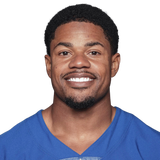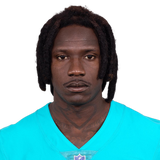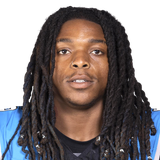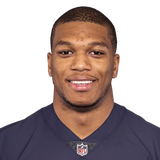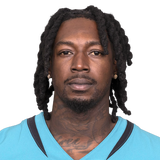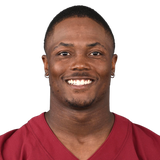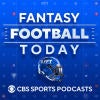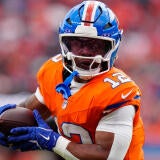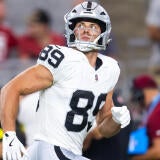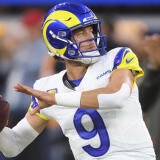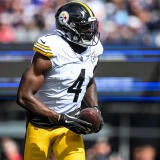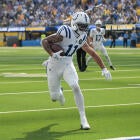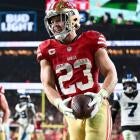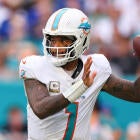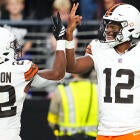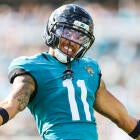Fantasy Football Wide Receiver Preview: Rookie receivers are short on projections but long on upside
We may not project a big year for any of the rookies, but that doesn't mean you shouldn't draft them.
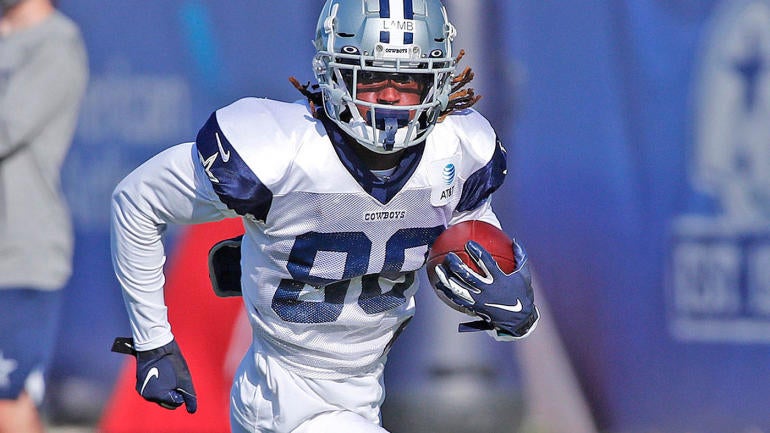
The 2019 season was one of the best in recent memory for rookie receivers, and the 2020 class was loaded with talent. Despite that, the 2020 class is not being projected, or drafted, to come even close to what happened last year. Part of that is likely due to the abbreviated offseason. It's also true that receiver is so deep, it's hard to fit the rookies in your top 36. But don't let that fool you into thinking they don't have upside.
CeeDee Lamb landed in the best offense of the group and is just one injury away from 120-plus targets. And he's so talented, he may not even need an injury. But Amari Cooper has been hobbled at camp, which is definitely something to watch. Jerry Jeudy is right there with Lamb from a pedigree perspective and should slot in as Denver's No. 2 receiver. If Drew Lock takes a step forward, it's not that hard to imagine Jeudy having a big second half and possibly overtaking Courtland Sutton by the end of the year. The rookie with the most immediate opportunity is Henry Ruggs, who already profiles as the Raiders' best receiver. While no one gets excited about Derek Carr's receivers, it's worth noting that he was the quarterback when Cooper topped 1,000 yards as a rookie in 2015.
While those are the top three rookies in terms of upside, that doesn't mean they're the only rookies with upside. We generally advise against targeting them as starters, but you'd be well advised to have a few on your bench including one of my favorite sleepers below.
While we've jam-packed all the re-draft information we can into one article, you'll have to settle for links for the Dynasty content. Our Dynasty running back rankings are here and our Dynasty Tiers can be found here.
Before we get to the potential league-winners, it's probably worthwhile to take a quick look at the state of the position. While Michael Thomas still stands out in PPR projections, it bunches up really quick. There are 22 wide receivers within 10% in projection points one direction or another of my No. 12 wide receiver (Kenny Golladay). That's nearly twice as many wideouts as running backs who fall into the same category. There are also an inordinate number of receivers under 25 who weren't top-10 receivers last year but absolutely have top-five upside in 2020.
And the depth doesn't run out as the draft goes on. There are 55 receivers projected to average 10 PPR Fantasy points per game, compared to just 28 running backs. This depth coupled with the fact that almost every elite receiver besides Thomas had a down year last year helps explain why people are so hesitant to draft receivers in the first two rounds. But is that the right strategy?
Wide receiver draft strategy
Your wide receiver strategy this year will be determined by your draft slot and just how wild your league goes for running backs. If you have a pick in the first four, you're starting with at least one running back and there's a decent chance you get through the first three rounds with zero or one receivers. That's OK, because there's no shortage of high-upside wide receivers at the four-five turn. If you're picking in the middle of the round, you're only taking a receiver in the first if Thomas falls to you, and the same is true at the end of the round; just add Davante Adams (possibly Julio Jones and Tyreek Hill) to the list.
How you handle receivers in the middle of the draft is highly dependent on how many you already have and how confident you are in their floor. Tyler Boyd, Jarvis Landry and Julian Edelman are excellent PPR floor options in the middle rounds, but if you're looking for upside, Marquise Brown, A.J. Green, and Brandin Cooks are far better targets. Just make sure you have a balance of both in your receiving corps.
There are some receivers whose value changes drastically from PPR to non (more on that below), but the main consideration should be how many you have to start. Just remember that in a PPR league, each flex is like needing another starting wide receiver, because the position is so much deeper. Unless you start with three straight running backs, you're almost always better flexing a receiver. So a league that starts three receivers with multiple flexes makes receivers a much higher priority in the middle rounds than an old school league with two receivers and no flexes.
Finally, the rookies are terrifying because of their lack of an offseason and less than ideal landing spots. One strategy I really like is a modified version of Adam Aizer's friendship strategy. Pairing Michael Gallup with Lamb or Sutton with Jeudy is a cost effective way to take a pair of shots on upside. Pairings like Deebo Samuel and Brandon Aiyuk or DeSean Jackson and Jalen Raegor don't have quite as much upside, but they're a lot cheaper.
Now let's get to sleepers, breakouts and bust. One quick note, ADP here is current CBS ADP.
The New York Giants may have too many mouths to feed, but all the evidence we have suggests Sterling Shepard should be the first receiver drafted. And he should be drafted at least two rounds earlier than he currently is. Shepard was close to a 25% target share when he was healthy in 2019 and was over 8 yards per target in both 2017 and 2018. If he can combine those two numbers, he's got a shot at being a low-end No. 2 receiver. At the very least he should be a solid No. 3 if he stays healthy.
| ||||||||||||||||||||
Before he tore his ACL, Preston Williams had more targets, catches and yards than DeVante Parker. Parker is currently being drafted four rounds higher. Entering camp that made some sense because Williams was still recovering and Parker was healthy. But now Williams looks like a full go and Parker is having a hard time staying on the field. The Dolphins had both Albert Wilson and Allen Hurns opt out due to COVID-19 concerns, so this should be a very consolidated passing attack. Williams may very well be the No. 1 receiver for the Dolphins just like he was before he went down in 2019.
| ||||||||||||||||||||
Shenault has been available in the last round of most drafts all offseason, but that won't last long after whispers started coming out about comparisons to Anquan Boldin and Andre Johnson. That's not fair to Shenault, but he is an excellent prospect on a team that should top 600 pass attempts and doesn't have a solidified No. 2 behind D.J. Chark. Jacksonville has also talked about using him in the running game, adding just a little more intrigue and upside.
| ||||||||||||||||||||
You'd be right to believe D.J. Moore already broke out in 2019. You'd be wrong to think he's done breaking out. For a 22-year-old to put up more than 1,100 yards in just over 14 games catching passes from the likes of Kyle Allen and Will Grier is pretty special. Now he gets a quarterback upgrade in Teddy Bridgewater and hopefully a lot better touchdown luck. There are only a few receivers who could legitimately challenge a healthy Michael Thomas in PPR this season. Moore is one of them. He projects as one my top five receivers, but he has No. 1 overall upside.
| ||||||||||||||||||||
The Atlanta Falcons figure to be one of the best bets in the NFL to throw at least 600 passes in 2020, and lucky for Calvin Ridley they also look like one of the most consolidated attacks. Julio Jones, Ridley and Hayden Hurst should dominate targets, and Ridley stands to take a big leap — something we got a glimpse of after the team dealt Mohamed Sanu. Ridley averaged 8.2 targets and 82.2 receiving yards in five and a half games without Sanu. There's legitimate top-10 upside even if Hurst sees 100 targets and Jones plays 16 games.
| ||||||||||||||||||||
Terry McLaurin showed us he could be a star with even adequate quarterback play last year. In the first four games he had 408 receiving yards and five touchdowns. After a midseason slump he finished strong with Dwayne Haskins, and the expectation should be that Haskins improves in his second year. Washington didn't add anyone who should impact McLaurin's target share, and his new offensive coordinator was a part of the second-most pass happy attack in the league in 2019. There's top-12 upside here, and you don't even have to squint to see it.
| ||||||||||||||||||||
Because running backs are going so early, you really have to look more at where the receivers are being drafted. DeAndre Hopkins is currently the fifth receiver off the board, and that's terrifying to me. Last year's 7.8 yards per target was the second-lowest mark of Hopkins' career, and that matters because he figures to see a serious reduction in targets. Kliff Kingsbury runs a spread offense, and targets will be spread around between Hopkins, Christian Kirk, Larry Fitzgerald and Kenyan Drake. If you give Hopkins 140 targets at his career efficiency, you're looking at 1,148 yards and seven scores. And there's no guarantee he matches his career efficiency with a less experienced quarterback.
| ||||||||||||||||||||
Numbers to know
149 -- Michael Thomas had never seen more than 149 targets in a season before he broke an NFL record with 185 in 2019. With Emmanuel Sanders in town and Alvin Kamara 100%, we should expect Thomas' target share to fall by at least 10% in 2020.
10.96 -- Davante Adams has averaged nearly 11 targets per game over the past three season. The Packers did nothing this offseason to lead us to believe that will change.
9.9 -- Tyreek Hill and Tyler Lockett have both averaged 9.9 yards per target over their careers, which is better than any other player since we started tracking that number.
61% -- Cooper Kupp's snap rate was 61% or lower in three of the final four games for the Rams. That coincided with Tyler Higbee going bananas.
448 -- The Titans haven't thrown more than 448 passes in a season since 2017. It's going to be very difficult for A.J. Brown to improve on his rookie year if the Titans are below 500 pass attempts.
9 -- A.J. Green has played nine games since 2017. And he's 32 years old.
0 -- Julian Edelman has never caught a touchdown pass in the NFL from anyone other than Tom Brady.
1809 -- Mike Evans was second in total air yards, behind only Julio Jones. Brandin Cooks is the only Tom Brady receiver to top 1,500 air yards in the past five years, and he failed to reach this mark despite playing three more games than Evans.
Format matters
Most of this piece, including tiers and ADP, are based on PPR leagues. We recognize many of you still play in non-PPR. Here's a list of players who we expect to be significantly better, and worse, in non-PPR:
Better in non-PPR: Kenny Golladay, Mike Evans, Amari Cooper, A.J. Brown, Michael Gallup, Marvin Jones
Worse in non-PPR: Adam Thielen, DeAndre Hopkins, JuJu Smith-Schuster, Allen Robinson, Keenan Allen, Robert Woods, Julian Edelman, Sterling Shepard, Jamison Crowder



